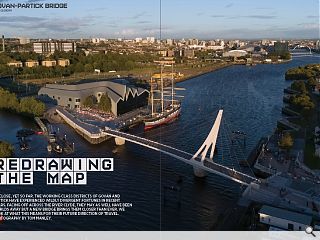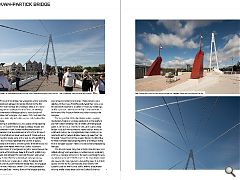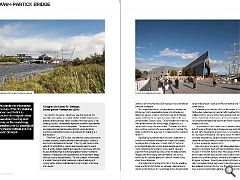Redrawing the Map
31 Oct 2024
So close, yet so far, the working class districts of Govan and Partick have experienced wildly divergent fortunes in recent years. Facing off across the Clyde, they may as well have been worlds away but a new bridge brings them closer than ever. We look at what this means for their future direction of travel. Photography by Tom Manley.
A £29.5m pedestrian bridge has swung into action to provide a physical bond between Govan and Partick for the first time. More than a bridge the crossing is billed as the key to unlocking the untapped potential of Govan, shouldering not just the weight of thousands but a heavy burden of expectation from Glasgow City Council that it will boost the economy, community and culture across both banks of the River Clyde.
Drawing an estimated 200,000 people on the opening weekend the Govan-Partick Bridge is already established as a destination in itself, harnessing the potent power of agglomeration to ensure spillover benefits of the Transport Museum are felt across Govan and beyond. Conceived as a pressure valve to take some of the heat out of a gentrifying Partick the link made headlines when a river of people descended on the area to see the sight for themselves but it is the longer-term impact which most excites its backers.
In basic terms the bridge knits together Water Row on the south bank with Pointhouse Quay to the north, establishing a walkable link between the Riverside Museum and Govan Subway Station. But the scale, budget and engineering on show hints at a far grander ambition. Funded by both Scottish and UK governments the bridge has a moving span length of 99m, linked to a further 15.7m fixed span section at Pointhouse Quay - making it one of the longest opening pedestrian/cycle bridges in Europe. There remains some debate until Guinness World Records award their plaque but the closest UK equivalent is Salford’s Media City footbridge, an 83m span over the Manchester Ship Canal connected to the Imperial War Museum North and a clear inspiration for Glasgow.
The Glasgow Partick Bridge likewise adopts a swing mechanism, hinging on a single pivot point on the southern pier with loads transferred via a dramatic 29m tall splayed pylon in the form of an inverted ‘v’ the cable-stayed swing bridge holds aloft two connecting spans each six metres in width and inviting the unimaginatively titled crossing to be referred to as the Swivelly Bridge. Sweeping away from the Riverside Museum to minimise visual intrusion, its distinctive forward inclination references the profile of a crane jib rising from a triangular support frame, a nod to Govan’s shipbuilding heritage.
The disused Govan Ferry inlet at Water Row has also been infilled although care was taken to restore two red oxide ferry winches, a nostalgic reference to the past. Describing the view as a ‘picture postcard’ Chris Burrows of the city’s development and regeneration services team stressed the need to maintain access for river traffic. Burrows told Urban Realm: “We couldn’t close the river to boat traffic, there is an aspiration to bring smaller cruise ships up to the Scottish Exhibition Centre so we’ve maintained a 50m navigation channel with an unlimited air draught.” This engineering feat is made possible by an impressive 650-tonne moving span built by Farrans Construction to designs by Jacobs, a mass of steel which can be effortlessly opened and closed in a couple of minutes. River traffic must provide at least 6 hours’ notice.
Citing reliability as the driving force behind moves for a swing bridge, as opposed to a bascule or lift design, Burrows added: “The view from Water Row is picture postcard. We were careful not to foul that. The bridge is offset to the quay wall to complement the Transport Museum.”
Significant groundworks have also been undertaken to enhance the immediate setting of the bridge including the reconfiguration of quay walls on both sides of the river to accommodate approach ramps, bridge landing and public realm comprising stone seating cubes, granite slabs and steps which have already become a draw for skateboarders. Plugging into the existing riverside walkway the route is framed by the powerful gables of Collective Architecture’s Water Row masterplan.
At a stroke the link redraws the map of the city, enabling Govan and Partick to function as a singular urban area and thrusting both firmly on the tourist map, finally unleashing the full potential of assets such as the Pearce Institute and The Govan Stones. The bridge re-establishes a historic link severed in the 1960s when pedestrian and vehicle traffic switched from the established ferry service to the newly opened Clyde Tunnel further downstream. Harking back to this more sedate age are two winches that raised and lowered the former road ramp subject to the tides.
Long considered places apart the combined gravitational pull of Govan and Partick has introduced a new destination in its own right, ensuring the area punches its full weight across the city region and beyond. Linking the Queen Elizabeth University Hospital and Glasgow University’s fast-growing Gimorehill campus promises to establish a metaphorical river of people, knowledge and prosperity. Early signs are encouraging with Glaswegians already taking the crossing to heart with opening festivals showcasing the best of what both have to offer. This success will have been in vain however should Govan lose its distinct identity amidst a likely influx of people, money and development from its bigger neighbour.
Towering new apartment blocks already stand somewhat incongruously next to the show people on land adjacent to Govan Old. For now, though the direction of travel is positive with people gaining a spring in their step.
|
|





